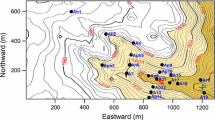Abstract
Turbulence data from the planetary boundary layer (PBL) indicate the presence of deterministic turbulent structures. These structures often show up as asymmetric ramp patterns in measurements of the turbulent fluctuations of a scalar quantity in the atmospheric surface layer (ASL). The sign of the slope of the sharp upstream edge of such a triangular pattern depends on the thermal stability conditions of the ASL.
The turbulent structures in the ASL have been tracked by a detection method which searches for rapid and strong fluctuations in a signal — the VITA (variable interval time averaging) technique. This detection method has previously been employed in laboratory boundary layers. The VITA detection method performs well in the ASL and reveals the presence of vertically coherent turbulent structures, which look similar to those in laboratory shear flows. At the moment that a sharp temperature interface appears, the horizontal alongwind velocity shows a sharp increase, along with a sudden decrease of vertical velocity, independent of the thermal stability conditions of the ASL. The fluctuating static pressure reveals a maximum at that moment. The vertical turbulent transports show a twin-peak character around the time that the sharp jumps in the temperature and the velocity signals appear.
Similar content being viewed by others
References
Antonia, R. A., Chambers, A. J., Friehe, C. A., and Van Atta, C. W.: 1979, ‘Temperature Ramps in the Atmospheric Surface Layer’, J. Atmos. Sci. 36, 99–108.
Blackwelder, R. F. and Kaplan, R. E.: 1976, ‘On the Wall Structure of the Turbulent Boundary Layer’, J. Fluid Mech. 76, 89–112.
Chen, C.-H. P. and Blackwelder, R. F.: 1978, ‘Large-Scale Motion in Turbulent Boundary Layer: A Study Using Temperature Contamination’, J. Fluid Mech. 89, 1–31.
Driedonks, A. G. M., Dop, H. van, and Kohsiek, W. H.: 1978, ‘Meteorological Observations on the 213 m Mast at Cabauw in The Netherlands’, 4th Symp. Met. Obs. Instr., Denver, Colorado.
Driedonks, A. G. M., Nieuwendijk, P. A. T., and Goes, C. J.: 1980, ‘A Set of Computer Programs to Process Turbulence Data, Measured at the 200 m Mast at Cabauw’, Sci. Rep. W.R. 80-3 K.N.M.I.
Driedonks, A. G. M.: 1981, ‘Dynamics of the Well-Mixed Atmospheric Boundary Layer’, Sci. Rep. W.R. 81-2 K.N.M.I.
Elliott, J. A.: 1972, ‘Instrumentation for Measuring Static Pressure Fluctuations within the Atmospheric Boundary Layer’, Boundary-Layer Meteorol. 2, 476–495.
Haugen, D. A., Kaimal, J. C., and Bradley, E. F.: 1971, ‘An Experimental Study of Reynolds Stress and Heat Flux in the Atmospheric Surface Layer’, Quart. J. Roy. Meteorol. Soc. 97, 168–180.
Johansson, A. V. and Alfredsson, P. H.: 1982, ‘On the Structure of Turbulent Channel Flow’, J. Fluid Mech. 122, 295–314.
Kaimal, J. C. and Businger, J. A.: 1970, ‘Case Studies of a Convective Plume and Dust Devil’, J. Appl. Meteorol. 9, 612–620.
Kaplan, R. E. and Laufer, J.: 1968, ‘The Intermittent Turbulent Region of the Boundary Layer’, Univ. South. Calif. Rep. USCAE 110.
Phong-Anant, D., Antonia, R. A., Chambers, A. J., and Rajagopalan, S.: 1980, ‘Features of the Organized Motion in the Atmospheric Surface Layer’, J. Geophys. Res. 85, 424–432.
Subramanian, C. S., Rajagopalan, S., Antonia, R. A., and Chambers, A. J.: 1982, ‘Comparison of Conditional Sampling and Averaging Techniques in a Turbulent Boundary Layer’, J. Fluid Mech. 123, 335–362.
Taylor, R. J.: 1958, ‘Thermal Structures in the Lowest Layers of the Atmosphere’, Austr. J. Phys. 11, 168–176.
Tennekes, H.: 1970, ‘Free Convection in the Turbulent Ekman Layer of the Atmosphere’, J. Atmos. Sci. 27, 1027–1034.
Thomas, A. S. W. and Bull, M. K.: 1983, ‘On the Role of Wall-Pressure Fluctuations in Deterministic Motions in the Turbulent Boundary Layer’, J. Fluid Mech. 128, 283–332.
van Maanen, H. R. E. and Fortuin, J. M. H.: 1983, ‘Experimental Determination of the Random Lump-Age Distribution in the Boundary Layer of the Turbulent Pipe Flow using Laser-Doppler Anemometry’, Chem. Engineering Sci. 38 (3), 399–423.
Author information
Authors and Affiliations
Rights and permissions
About this article
Cite this article
Schols, J.L.J. The detection and measurement of turbulent structures in the atmospheric surface layer. Boundary-Layer Meteorol 29, 39–58 (1984). https://doi.org/10.1007/BF00119118
Accepted:
Issue Date:
DOI: https://doi.org/10.1007/BF00119118




